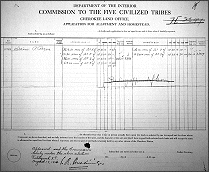Teaching With Documents:
Maps of Indian Territory, the Dawes Act, and Will Rogers' Enrollment Case File
Background
Federal Indian policy during the period from 1870 to 1900 marked a departure from earlier policies that were dominated by removal, treaties, reservations, and even war. The new policy focused specifically on breaking up reservations by granting land allotments to individual Native Americans. Very sincere individuals reasoned that if a person adopted white clothing and ways, and was responsible for his own farm, he would gradually drop his Indianess and be assimilated into the population. Then there would be no more necessity for the government to oversee Indian welfare in the paternalistic way it had been obligated to do, or provide meagre annuities that seemed to keep the Indian in a subservient and poverty stricken position.
On February 8, 1887, Congress passed the Dawes Act, named for its author, Senator Henry Dawes of Massachusetts. Also known as the General Allotment Act, the law allowed for the president to break up reservation land, which was held in common by the members of a tribe, into small allotments to be parceled out to individuals. Thus, Native Americans registering on a tribal "roll" were granted allotments of reservation land. “To each head of a family, one-quarter of a section; To each single person over eighteen years of age, one-eighth of a section ; To each orphan child under eighteen years of age, one-eighth of a section; and To each other single person under eighteen years now living, or who may be born prior to the date of the order of the President directing an allotment of the lands embraced in any reservation, one-sixteenth of a section…”
Section 8 of the act specified groups that were to be exempt from the law. It stated that "the provisions of this act shall not extend to the territory occupied by the Cherokees, Creeks, Choctaws, Chickasaws, Seminoles, and Osage, Miamies and Peorias, and Sacs and Foxes, in the Indian Territory, nor to any of the reservations of the Seneca Nation of New York Indians in the State of New York, nor to that strip of territory in the State of Nebraska adjoining the Sioux Nation on the south."
Subsequent events, however, extended the act's provisions to these groups as well. In 1893, President Grover Cleveland appointed the Dawes Commission to negotiate with the Cherokees, Creeks, Choctaws, Chickasaws, and Seminoles, who were known as the Five Civilized Tribes. As a result of these negotiations, several acts were passed that allotted a share of common property to members of the Five Civilized Tribes in exchange for abolishing their tribal governments and recognizing state and federal laws.
In order to receive the allotted land, members were to enroll with the Bureau of Indian Affairs. Once enrolled, the individual's name went on the "Dawes rolls." This process assisted the BIA and the secretary of the interior in determining the eligibility of individual members for land distribution.
The purpose of the Dawes Act and the subsequent acts that extended its initial provisions was purportedly to protect Indian property rights, particularly during the land rushes of the 1890s, but in many instances the results were vastly different. The land allotted to the Indians included desert or near-desert lands unsuitable for farming. In addition, the techniques of self-sufficient farming were much different from their tribal way of life. Many Indians did not want to take up agriculture, and those who did want to farm could not afford the tools, animals, seed, and other supplies necessary to get started. There were also problems with inheritance. Often young children inherited allotments that they could not farm because they had been sent away to boarding schools. Multiple heirs also caused a problem; when several people inherited an allotment, the size of the holdings became too small for efficient farming.
The documents featured here include maps of Indian Territory before and after enactment of the Dawes Act and two documents from the 21-page enrollment application of American humorist Will Rogers.
Resources
The Dawes Act or General Allotment Act of 1887. U.S. Statutes at Large 24:388-91 (Available online fromOur Documents at http://www.ourdocuments.gov/doc.php?doc=50&page=transcript).
Kelly, Lawrence C. Federal Indian Policy. New York: Chelsea House Publishers, 1990.
The Documents
Map of Indian Territory
(Oklahoma), 1885
Click to Enlarge
National Archives and Records Administration
Records of the General Land Office
Record Group 49
Map of Indian Territory
(Oklahoma), 1891
Click to Enlarge
National Archives and Records Administration
Records of the General Land Office
Record Group 49
Clement V. and William P. Rogers' Application
For Enrollment in the Five Civilized Tribes
Testimony of Clement V. Rogers, October 22, 1900 (Page 3)
William P. Rogers' Application for Allotment and Homestead (Page 5)
View Pages: 1 | 2 | 3 | 4 | 5 | 6 | 7 | 8 | 9 | 10
11 | 12 | 13 | 14 | 15 | 16 | 17 | 18 | 19 | 20 | 21
National Archives and Records Administration
Records of the Bureau of Indian Affairs
Record Group 75
Article Citation
This article was written by Kerry C. Kelly, a teacher at Hunterdon Central Regional High School, in Flemington, NJ.


Replies
PLDC and public auctions are deadly to DHHL.